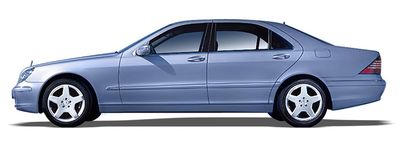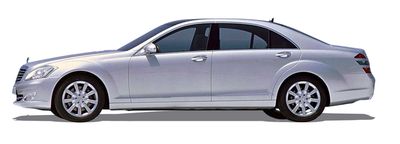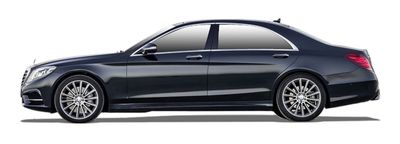Mercedes-Benz S-Class engines
Since its launch in 1972, the Mercedes-Benz S-Class has established itself as the epitome of automotive luxury and technological innovation. Across seven generations, the S-Class presented an impressive range of engines, from economical diesels to powerful V12 engines, always driving the latest developments in engine technology.

Mercedes-Benz S-Class Generation I-III (1972-1998): Historic generations

The first three generations of the Mercedes-Benz S-Class (W116, W126, W140) laid the foundation for the model series' reputation as a technological pioneer. These historic Mercedes-Benz S-Class engines achieved mileages of 400,000 to 600,000 kilometers with proper maintenance, whereby the large-volume V8 engines were particularly durable. Major repairs were usually only necessary after 250,000 to 350,000 kilometers, mainly on automatic transmissions and air suspensions. The absolute highlight was the M117 5.0-liter V8 (1979-1991), which perfectly combined power, reliability and smooth running. The W126 generation (1979-1991) is considered the most reliable of all historic S-Class generations, while the W140 (1991-1998) became more vulnerable due to its complex electronics.
Mercedes-Benz S-Class gasoline engines: Historic generations (1972-1998)
The Mercedes-Benz S-Class petrol engines of the first three generations mainly comprised six-cylinder in-line engines (M110, M103) with a displacement of 2.8 to 3.0 liters and 160-188 hp as well as the legendary V8 engines (M116, M117) with 3.5 to 5.6 liters and 200-300 hp. The M110 2.8-liter in-line engine of the W116 proved to be particularly robust, while the M117 5.0-liter V8 of the W126 is considered the best petrol engine of the era. The W140 generation introduced the first V12 engine (M120) with 6.0 liters and 408 hp, but it was prone to cooling system problems. Typical weaknesses of all Mercedes-Benz S-Class petrol engines of this period were valve stem seals, chain tensioners and, in the case of the V8 engines, occasional cylinder head gaskets.
Mercedes-Benz S-Class diesel engines: Historical generations (1972-1998)
Mercedes-Benz S-Class diesel engines began in 1979 with the OM617 3.0-liter five-cylinder (125 hp) in the W126 generation. This engine developed into the most reliable powertrain in the entire history of the S-Class, regularly achieving over 500,000 kilometers. The W140 introduced the more modern OM606 3.0-liter inline six-cylinder engine (136-177 hp), which was also very durable. The OM603 3.5-liter six-cylinder engine (150 hp) completed the diesel range and was considered the most powerful, but also the most vulnerable diesel of this generation.
| Mercedes S-Class engine |
Power output |
Fuel consumption |
Typical weaknesses |
Rating |
| M110 2.8 R6 |
160-185 HP |
12-14 l/100km |
Valve stem seals, chain tensioner |
Very good |
| M116/M117 V8 |
200-300 HP |
14-18 l/100km |
Cylinder head gasket, cooling system |
Very good |
| M120 V12 |
408 HP |
16-20 l/100km |
Cooling system, electronics |
Average |
| OM617 Diesel |
125 HP |
9-11 l/100km |
Practically indestructible |
Very good |
| OM603/OM606 Diesel |
136-177 HP |
8-10 l/100km |
Injection pump, glow plugs |
Good |

Mercedes-Benz S-Class Generation IV (1998-2006)

The fourth generation of the Mercedes-Benz S-Class (W220) marked a turning point in the quality history of the model series and is considered the most problematic of all S-Class generations. Mileage dropped to between 200,000 and 300,000 kilometers, with costly repairs to the air suspension, electronics and engines occurring between 80,000 and 150,000 kilometers. The early models (1998-2002) in particular suffered from quality problems, which were only partially rectified with the 2002 facelift. The best engine of this generation was the M113 5.0-liter V8 with 306 hp, which still offered the traditional Mercedes reliability despite all the problems of the W220 generation. The complex electronics and the susceptible Airmatic air suspension had a negative impact on this generation.
Mercedes-Benz S-Class petrol engines: Generation IV (1998-2006)
The Mercedes-Benz S-Class gasoline engines of the W220 included the M112 V6 (3.2 liters, 224 hp), the M113 V8 engines (4.3 and 5.0 liters, 279-306 hp) and the M137 V12 (5.8 liters, 367 hp). The M112 V6 proved to be the most vulnerable engine with frequent problems with balancer shafts and oil pumps. The M113 V8 engines were much more reliable, with the 5.0-liter considered the best petrol engine of this generation. The M137 V12 suffered from cooling system problems and complex electronics. All Mercedes-Benz S-Class engines of this generation struggled with mass air flow sensor and ignition coil problems.
Mercedes-Benz S-Class diesel engines: Generation IV (1998-2006)
Mercedes-Benz S-Class diesel engines were limited to the OM628 4.0-liter V8 (250 hp) and the OM613 3.2-liter inline six-cylinder (197 hp). The OM628 V8 diesel was a technical masterpiece, but prone to problems with the common rail injection and the exhaust gas recirculation system. The smaller OM613 proved to be more reliable, but did not achieve the smooth running of the V8 variant. Both Mercedes-Benz S-Class diesels suffered from the typical problems of early common-rail technology.
| Mercedes S-Class engine |
Power output |
Fuel consumption |
Typical weaknesses |
Rating |
| M112 V6 |
224 HP |
10-12 l/100km |
Balancer shafts, oil pump |
Problematic |
| M113 V8 |
279-306 HP |
12-15 l/100km |
Mass air flow sensor, ignition coils |
Good |
| M137 V12 |
367 HP |
14-17 l/100km |
Cooling system, electronics |
Moderate |
| OM613 Diesel |
197 HP |
8-10 l/100km |
Common rail problems |
Average |
| OM628 V8 Diesel |
250 HP |
9-11 l/100km |
Injection, EGR system |
Moderate |

Mercedes-Benz S-Class Generation V (2006-2013)

The fifth generation of the Mercedes-Benz S-Class (W221) represented a significant improvement in quality compared to the previous generation and again achieved mileages of 250,000 to 400,000 kilometers. Major repairs were usually only required after 150,000 to 250,000 kilometers, mainly on the air suspension and electronics. The absolute highlight was the M156 6.2-liter V8 with 525 hp in the S63 AMG, which was surprisingly reliable despite its performance. The W221 introduced hybrid technology to the S-Class for the first time and offered a well-balanced mix of luxury, performance and renewed reliability. Most of the engines of this generation are considered to be significantly more robust than their W220 predecessors.
Mercedes-Benz S-Class petrol engines: Generation V (2006-2013)
The Mercedes-Benz S-Class gasoline engines of the W221 included the M272 V6 (3.0 and 3.5 liters, 231-272 hp), the M273 V8 engines (4.7 and 5.5 liters, 388-435 hp), the M156 6.2-liter V8 (525 hp) and the M275 V12 (5.5 liters, 517 hp). The M272 V6 was prone to problems with the balancer shafts and chain tensioners, especially the early variants. The M273 V8 engines proved to be reliable, with the 5.5-liter considered the best all-round engine of this generation. The M156 AMG engine was surprisingly robust for its power, while the M275 V12 suffered from ignition coil and cooling system problems.
Mercedes-Benz S-Class diesel engines: Generation V (2006-2013)
The Mercedes-Benz S-Class diesel engines included the OM642 3.0-liter V6 (235 hp) and the OM629 4.0-liter V8 (320 hp). The OM642 developed into the most reliable diesel in S-Class history and regularly reached over 400,000 kilometers. Typical weaknesses were only problems with exhaust gas recirculation and occasionally with injectors. The OM629 V8 diesel was more powerful, but more prone to problems with the common rail injection.
Mercedes-Benz S-Class hybrid drive: Generation V (2006-2013)
From 2009, the S400 Hybrid was offered with a combination of M272 V6 (279 hp) and electric motor (20 hp). This first Mercedes-Benz S-Class hybrid was more of a technology demonstrator than a mature system and suffered from complex electronics and high maintenance costs.
| Mercedes S-Class engine |
Power output |
Fuel consumption |
Typical weaknesses |
Rating |
| M272 V6 |
231-272 HP |
9-11 l/100km |
Balancer shafts, chain tensioner |
Average |
| M273 V8 |
388-435 HP |
11-14 l/100km |
Robust, few problems |
Very good |
| M156 AMG V8 |
525 HP |
13-16 l/100km |
Surprisingly reliable |
Good |
| M275 V12 |
517 HP |
13-16 l/100km |
Ignition coils, cooling system |
Moderate |
| OM642 V6 Diesel |
235 HP |
7-9 l/100km |
EGR system, injectors |
Very good |
| OM629 V8 diesel |
320 HP |
8-10 l/100km |
Common rail problems |
Good |
| S400 Hybrid |
299 HP |
7.9 l/100km |
Complex electronics |
Average |

Mercedes-Benz S-Class Generation VI (2013-2020)

The sixth generation of the Mercedes-Benz S-Class (W222) set new standards in terms of efficiency and technology and achieved mileages of 300,000 to 450,000 kilometers. Major repairs were usually only required after 200,000 to 300,000 kilometers, mainly on the complex electronics and assistance systems. The absolute highlight was the M176 4.0-liter V8 biturbo with up to 630 hp, which perfectly combined power and efficiency. The W222 introduced a full plug-in hybrid range for the first time and offered the most balanced blend of performance, efficiency and reliability of any S-Class generation. Most of the engines of this generation are considered to be very mature and durable.
Mercedes-Benz S-Class petrol engines: Generation VI (2013-2020)
The Mercedes-Benz S-Class gasoline engines of the W222 included the M276 V6 (3.0 liter, 333 hp), the M278 V8 engines (4.7 liter, 455 hp), the new M176 4.0 liter V8 Biturbo (469-630 hp) and the M279 V12 (6.0 liter, 630 hp). The M276 V6 with biturbo charging proved to be a reliable and efficient engine, ideal for the basic S-Class. The M278 V8 was robust, but was quickly superseded by the more modern M176. The M176 4.0-liter V8 Biturbo developed into the best petrol engine in S-Class history, combining high performance with surprising reliability. The M279 V12 was technically mature, but complex and expensive to maintain.
Mercedes-Benz S-Class diesel engines: Generation VI (2013-2020)
The Mercedes-Benz S-Class diesel engines were limited to the further developed OM642 3.0-liter V6 (258-340 hp) and the new OM656 3.0-liter inline six-cylinder (286-340 hp from 2017). The OM642 achieved its highest reliability in this generation and is considered one of the best diesel engines of all time. The new OM656 was even more efficient and cleaner, but more prone to problems due to the more complex exhaust gas aftertreatment.
Mercedes-Benz S-Class plug-in hybrids: Generation VI (2013-2020)
The Mercedes-Benz S-Class plug-in hybrids included the S500e (M276 V6 + electric motor, 442 hp) and later the S560e (M276 V6 + electric motor, 469 hp). These systems were significantly more sophisticated than the earlier S400 Hybrid and offered an electric range of up to 50 kilometers. Reliability was good, but the complexity led to higher maintenance costs.
| Mercedes S-Class engine |
Power output |
Fuel consumption |
Typical weaknesses |
Rating |
| M276 V6 Biturbo |
333 HP |
8-10 l/100km |
Robust, few problems |
Very good |
| M278 V8 |
455 HP |
10-12 l/100km |
Reliable, but outdated |
Good |
| M176 V8 Biturbo |
469-630 HP |
9-13 l/100km |
Excellent reliability |
Very good |
| M279 V12 |
630 HP |
12-15 l/100km |
Complex, expensive |
Good |
| OM642 V6 Diesel |
258-340 HP |
6-8 l/100km |
Very reliable |
Very good |
| OM656 R6 Diesel |
286-340 HP |
5-7 l/100km |
Exhaust aftertreatment |
Good |
| S500e/S560e Hybrid |
442-469 HP |
2.8-3.2 l/100km |
Complex, but mature |
Good |

Mercedes-Benz S-Class Generation VII (2020-today)

The current Mercedes-Benz S-Class (W223) relies entirely on electrification and represents the future of the luxury saloon. All engines are at least mild hybrid, while the plug-in hybrids offer an electric range of over 100 kilometers. As the generation has only been on the market since 2020, no long-term experience is yet available, but the first tests show promising approaches for mileages of over 400,000 kilometers. The top-of-the-range engine is the M176 4.0-liter V8 biturbo with 48-volt system and up to 630 hp, which combines the proven reliability of the W222 engine with state-of-the-art efficiency technology. The new EQS variant as a fully electric vehicle marks the transition to electromobility.
Mercedes-Benz S-Class mild-hybrid petrol engines: Generation VII (2020-today)
The Mercedes-Benz S-Class petrol engines of the W223 include the M256 in-line six-cylinder (3.0 liters, 367-435 hp) with 48-volt mild hybrid and the proven M176 V8 biturbo (4.0 liters, 469-630 hp) also with 48-volt system. The M256 is a completely new engine with an electric compressor and integrated starter-generator, which proves to be very efficient and refined. The M176 V8 has been further developed and is considered the best engine of the current generation.
Mercedes-Benz S-Class diesel engines: Generation VII (2020-today)
The Mercedes-Benz S-Class diesels are limited to the OM656 3.0-liter inline six-cylinder (286-400 hp) with 48-volt mild hybrid system. This engine is a further development of the W222 unit and offers improved efficiency and cleanliness.
Mercedes-Benz S-Class plug-in hybrids: Generation VII (2020-today)
The Mercedes-Benz S-Class plug-in hybrids include the S580e (M256 + electric motor, 510 hp) with an electric range of over 100 kilometers. The system is significantly more powerful than its predecessors and offers an excellent balance between efficiency and performance.
Mercedes-Benz S-Class Electric Drive: Generation VII (2020-today)
The Mercedes EQS as an electric S-Class offers outputs from 333 to 761 hp and ranges of up to 770 kilometers. As a fully electric vehicle, it represents the future of the luxury saloon.
| Mercedes S-Class engine |
Power output |
Fuel consumption |
Typical weaknesses |
Rating |
| M256 R6 mild hybrid |
367-435 HP |
7-9 l/100km |
So far no series problems |
Very good |
| M176 V8 Mild-Hybrid |
469-630 HP |
9-12 l/100km |
Proven reliable |
Very good |
| OM656 R6 Diesel |
286-400 HP |
5-7 l/100km |
Exhaust aftertreatment |
Good |
| S580e plug-in hybrid |
510 HP |
0.9-1.3 l/100km |
Complex, but mature |
Very good |
| EQS Electric |
333-761 HP |
15-20 kWh/100km |
New technology |
Good |

Conclusion: The best Mercedes-Benz S-Class engines of all generations
The evolution of Mercedes-Benz S-Class engines shows a fascinating journey from mechanical perfection to electronic complexity to modern electrification. While the historic generations impressed with their longevity, the newer generations achieved a better balance between performance, efficiency and reliability. The current mild-hybrid and plug-in hybrid systems promise to define the future of the luxury sedan.
- Best Mercedes-Benz S-Class gasoline engine:
The M176 4.0-liter V8 Biturbo (Generation VI & VII) combines top performance with surprising reliability and state-of-the-art efficiency technology.
- Best Mercedes-Benz S-Class diesel engine:
The OM642 3.0-liter V6 (Generation V & VI) offers the best combination of reliability, economy and durability in S-Class history.
- Best Mercedes-Benz S-Class hybrid engine:
The S580e plug-in hybrid (Generation VII) with over 100 km electric range and 510 hp system output represents the perfect combination of luxury and efficiency.
For maintenance and spare parts for all Mercedes-Benz S-Class generations, AUTODOC offers a comprehensive range of original and quality spare parts with fast delivery and expert advice.






















